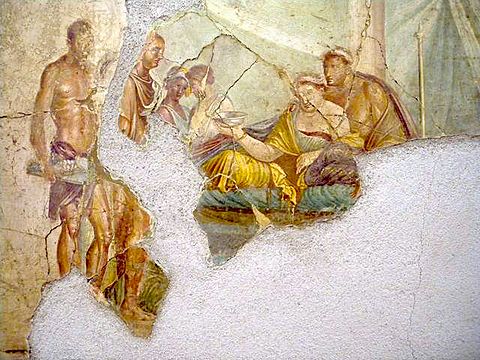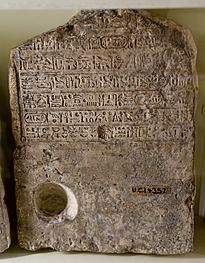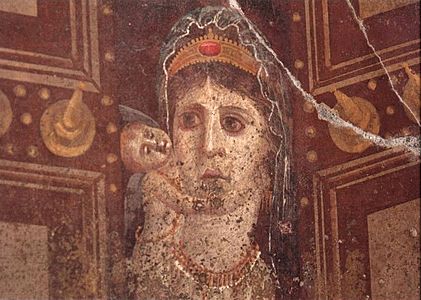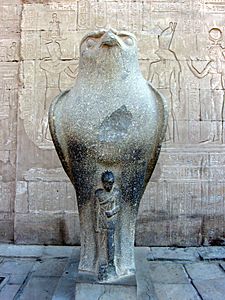Caesarion facts for kids
Quick facts for kids Caesarion |
|
|---|---|
| Ancient Greek: Πτολεμαῖος Φιλοπάτωρ Φιλομήτωρ Καῖσαρ, Καισαρίων Ptolemaĩos Philopátōr Philomḗtōr Kaĩsar, Kaisaríōn |
|
 |
|
| King of the Ptolemaic Kingdom | |
| Reign | 2 September 44 BC – late August 30 BC with Cleopatra VII (until 12 August 30 BC) (Ptolemaic dynasty) |
| Predecessor | Ptolemy XIV and Cleopatra VII |
| Successor | Position abolished |
| Father | Julius Caesar (allegedly) |
| Mother | Cleopatra VII |
| Born | 23 June 47 BC Ptolemaic Kingdom |
| Died | late August 30 BC (aged 17) Alexandria, Roman Egypt |
Ptolemy XV Caesar (born June 23, 47 BC – died August 30 BC), often called Caesarion (meaning "Little Caesar"), was the very last pharaoh of ancient Egypt. He ruled alongside his mother, Cleopatra VII, from 44 BC until her death in 30 BC. After Cleopatra died, he was the sole ruler for a short time. However, his death was ordered by Octavian, who later became the first Roman emperor.
Caesarion was the oldest son of Cleopatra. Many believed he was also the only biological son of the famous Roman leader Julius Caesar, and he was named after him. He was the last ruler from the Ptolemaic dynasty in Egypt.
Contents
Early Life of Caesarion
Ptolemy Caesar Philopator Philometor was born in Egypt on June 23, 47 BC. His mother, Cleopatra, strongly said that his father was the powerful Roman politician and dictator Julius Caesar. People said Caesarion looked like Caesar and acted like him.
However, Caesar never officially said Caesarion was his son. One of Caesar's friends, Gaius Oppius, even wrote a paper trying to prove that Caesar could not have been Caesarion's father. Still, Caesar might have let Caesarion use his name. This became a big argument later when Caesar's adopted son, Octavian, had problems with Cleopatra.
Caesarion spent two years of his early childhood, from 46 to 44 BC, in Rome. He and his mother were guests at Caesar's home. Cleopatra hoped her son would one day take over from his father as the leader of the Roman Republic and Egypt.
After Julius Caesar was killed on March 15, 44 BC, Cleopatra and Caesarion went back to Egypt. On September 2, 44 BC, when he was just three years old, Caesarion was named co-ruler with his mother. He was pharaoh in name only, as Cleopatra held all the real power. Cleopatra often compared her bond with her son to the Egyptian goddess Isis and her special child Horus.
There isn't much information about Caesarion between 44 BC and 36 BC. He appeared again in 36 BC and then in 34 BC at events called the "Donations." During these events, Cleopatra and Mark Antony gave lands controlled by Rome and Parthia to Cleopatra's children. These children included Caesarion, the twins Alexander Helios and Cleopatra Selene II, and Ptolemy Philadelphus. The last three were Caesarion's half-siblings, whose father was Mark Antony.
Right: a stone tablet showing the names of Cleopatra and Caesarion, from the Petrie Museum of Egyptian Archaeology, London
Caesarion Becomes Pharaoh
In 34 BC, Mark Antony gave more eastern lands and special titles to Caesarion and his own three children with Cleopatra. This happened during the Donations of Alexandria. Caesarion was declared to be a god and "King of Kings." This very grand title was unusual for how Rome usually dealt with its allied kings. It seemed to threaten the power of the Roman people.
Antony also said that Caesarion was Julius Caesar's true son and heir. This statement was a direct challenge to Octavian. Octavian's claim to power came from being Julius Caesar's grandnephew and adopted son. These declarations partly caused the big fight between Antony and Octavian. Octavian used the Roman people's anger about the "Donations" to get support for a war against Antony and Cleopatra.
The End of Caesarion's Life

After Mark Antony and Cleopatra lost the Battle of Actium in 31 BC, Cleopatra seemed to be preparing Caesarion to rule alone. She might have planned to go into hiding, perhaps with Antony. Caesarion is mentioned again in 30 BC, when Octavian invaded Egypt and looked for him.
Cleopatra may have sent Caesarion, who was 17 years old, to the Red Sea port of Berenice. This was likely for his safety, possibly as part of a plan to escape to India. The ancient writer Plutarch said that Caesarion was sent to India. But he also wrote that Caesarion was tricked into coming back by false promises of ruling Egypt.
Octavian captured the city of Alexandria on August 1, 30 BC. This date marked the official takeover of Egypt by the Roman Republic. Around this time, Mark Antony and Cleopatra died.
Octavian is believed to have ordered the death of Pharaoh Caesarion in Alexandria. He supposedly followed the advice of Arius Didymus, who said, "Too many Caesars is not good." This was a clever play on words from an ancient poem. The exact details of Caesarion's death are not fully known. After Caesarion's death, Octavian took complete control of Egypt.
How We Know About Caesarion
-
This Roman wall painting from Pompeii likely shows Cleopatra VII as the goddess Venus, with her son Caesarion as Cupid.
-
One of two statues of the falcon god Horus behind a smaller picture of Caesarion at the Temple of Edfu in Edfu, Upper Egypt.
Not many pictures or statues of Caesarion still exist today. A broken statue found in the harbor of Alexandria in 1997 is thought to be him. He is also shown twice in carvings as an adult pharaoh with his mother at the Temple of Hathor at Dendera. His image as a baby appears on some bronze coins made by Cleopatra.
Caesarion's Egyptian Names
Besides his Greek name and nicknames, Caesarion also had a full set of royal names in the Egyptian language:
- Iwapanetjer entynehem – meaning "Heir of the god who saves"
- Setepenptah – meaning "Chosen of Ptah"
- Irmaatenre – meaning "Carrying out the rule of Ra" or "Sun of righteousness"
- Sekhemankhamun – meaning "Living image of Amun"
See also
 In Spanish: Cesarión para niños
In Spanish: Cesarión para niños
- Caesareum of Alexandria
- Julia gens
- Reign of Cleopatra





